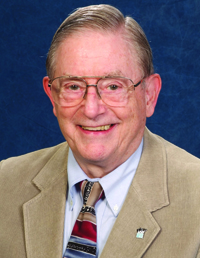
The recent awarding of the Noble Prize in Physics to a team of researchers for its invention of efficient blue light-emitting diodes (LED) brings to light the work of Texas A&M University faculty member, Dr. James R. “Bob” Biard.
The Royal Swedish Academy of Sciences awarded the Nobel Prize to Isamu Akasaki from Meijo University, Nagoya, Japan and Nagoya University, Japan, Hiroshi Amano of Nagoya University, Japan and Shuji Nakamura of the University of California, Santa Barbara, California.
However, long before their invention, Biard, a professor in the Department of Electrical and Computer Engineering, created the infrared LED while working at Texas Instruments (TI).
“We are proud that we have amongst us a colleague whose work is of the stature of a Nobel Prize,” said Dr. Chanan Singh, interim department head in the electrical and computer engineering department.
In the fall of 1961 Biard, along with Gary E. Pittman, were working together in the Semiconductor Research and Development Laboratory (SRDL) at TI creating GaAs tunnel diodes and GaAs varactor diodes used in X-band radar receivers. While investigating the valley current region of a tunnel diode constructed on a zinc diffused area of gallium arsenide semi-insulating substrate, they discovered a significant drop in resistance between the two Ohmic side contacts, when the diode was operated in forward bias.
The light emitted from the junction of the tunnel diodes, which could be seen at the edges of the chip. The varactor diodes had an etched mesa geometry and the light came out around the edge of the mesa. The photons were infrared, which cannot be seen by the human eye. Using an infrared image converter microscope recently brought in from Japan, they discovered all of the GaAs varactor diodes and tunnel diodes they had manufactured at the time emitted light.
On Aug. 8th, 1962, Biard and Pittman filed a patent based on their findings. After establishing the priority of their work based on engineering notebooks predating submissions from G.E. Labs, RCA Research Labs, IBM Research Labs, Bell Labs and Lincoln Labs at MIT, the U.S. patent office issued the two inventors the first patent for the infrared LED, also known as the first modern day LED. After filing the patent, TI immediately began a project to manufacture infrared diodes. It announced the first commercial LED product, the SNX-100, which sold for a price of $130 per unit in October 1962. Not long after their invention Nick Holonyak, Jr. developed the first visible-spectrum (red) LED in December 1962.
"We received $1 and other considerations for our patent," Biard joked, explaining that the amount they received was TI's policy whenever someone had received a patent while working there. Biard also received TI’s Patrick E. Haggerty Innovation Award for his many other contributions. "Of course it's not like I could have done that in my basement," he added.
Biard is most proud of the fact that his invention is still being used, after more than 50 years, in many devices such as remote controls, automated card readers and video cameras for digital photography.
"Not many inventions have a long life, he said. "The infrared LED is virtually unchanged and is used all the time."
Biard's invention led him to a long career in the field of opto-electronics in which he has excelled, receiving 77 U.S. and foreign patents which include the infrared LED, the Schottky bipolar transistor logic and the MOS ROM.
In 1969, Biard left TI to join Spectronics, Inc., when the company was founded, as vice president of research. While at Spectronics, Biard worked on the development of optical couplers used in a data bus developed for airborne avionics systems. He also worked on integrated circuits consisting of an LED driver and pin diode receiver used for digital fiber optic communications.
Spectronics, Inc. was acquired by Honeywell in 1978. From 1978 to 1987, Biard worked as chief scientist of the Honeywell Optoelectronics Division in Richardson, Texas. He started its MICROSWITCH IC & Sensor Design Center and served as a member of the Components Group Sensor Planning Team. He also was the Components Group representative on the Honeywell Technology Board (HTB), which was concerned with the development and transfer of technology throughout the Honeywell corporate structure.
Biard's product development responsibilities included optoelectronic components (light emitting diodes and photodetectors), fiber optic components, transmitter and receiver modules, silicon Hall effect sensors and pressure sensors.
After his time at Honeywell, Biard retired in December 1998 only to be hired back as a consultant. As a consultant, he became part of a team developing Vertical Cavity Surface Emitting Lasers (VCSELs). He also was involved in the interface between the MICRO SWITCH division, the Honeywell Corporate R&D Laboratory and universities.
Biard is a life fellow of the Institute of Electrical and Electronic Engineers (IEEE). He received the Honeywell Lund Award in 1989 and has been recognized as a distinguished alumnus of Texas A&M and has served at Texas A&M as an adjunct professor of electrical and computer engineering since 1985. In 1991 Biard was inducted into the National Academy of Engineering.
Despite his many accomplishments and the knowledge that his invention led to a Nobel Prize for these scientists, Biard remains humble. "I was in the right place at the right time," he said. "I'm happy for them."